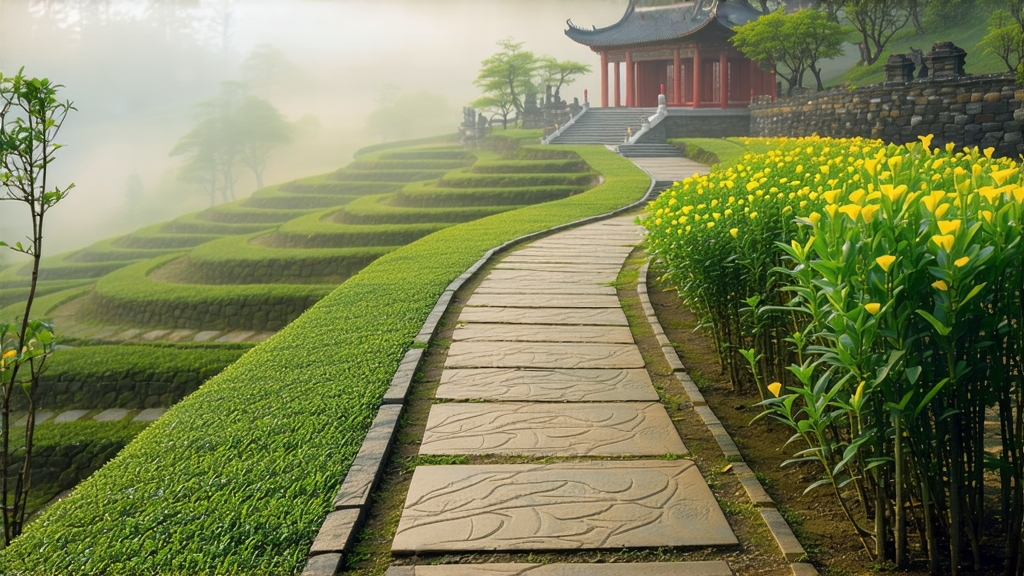
Tucked above the perpetual cloud belt on Meng Ding Mountain, Sichuan Province, grows one of China’s most discreet aristocrats of tea: Meng Ding Huang Ya, literally “Meng Ding Yellow Bud.” While green tea commands global fame and pu-erh enjoys cult status, yellow tea remains a whispered legend even inside China; within that niche, Meng Ding Huang Ya is the rarest surviving style, produced in batches measured not in tons but in kilograms each spring. To understand it is to step into a timeline that begins in the Tang dynasty (618-907 CE), winds through imperial tribute caravans, survives a mid-20th-century eclipse, and re-emerges today as the benchmark for “yellow leaf, yellow liquor” perfection.
Historical tapestry
The first written record appears in the 9th-century Classic of Tea, where Lu Yu praises “the yellow shoot of Meng Mountain” for its jade-colored infusion and sweet aftertaste. By the Song dynasty the buds were compressed into cakes and shipped to Kaifeng’s court; Ming emperors later decreed loose-leaf presentation, prompting local monks to invent the slow “sealed yellowing” technique that distinguishes the category. When the Qing lifted the tribute tax in 1735, production shrank to temple gardens, surviving only because monks used the tea as barter for incense and salt. Rediscovered in 1959 by provincial agronomists, Meng Ding Huang Ya became one of China’s Ten Famous Teas, yet acreage remains capped to protect the mist-forest ecology at 1,300–1,450 m elevation.
Micro-terroir
Meng Ding is actually a cluster of five peaks shrouded in 220 foggy days a year. The short-wave ultraviolet light diffused by mist forces the tea bush (a local Camellia sinensis var. sinensis clone named “Gan Zhu Zao”) to synthesize more theanine and less catechin, yielding a naturally brothy sweetness. Soils are Devonian sandstone leached by monsoon rains, acidic (pH 4.8–5.2) yet rich in selenium, an element credited with the tea’s signature orchid-honey finish. Temperature swings of 10 °C between day and night slow bud elongation; the picking window for the imperial grade is therefore only six days around Qingming festival, when each bud is 12–15 mm long, still unopened, and covered in silvery down.
Grades and leaf hierarchy
- Imperial Bud (特级黄芽): 100 % single bud, < 2 kg per mu.
- Superior One Leaf (一级黄芽): one bud plus the first unfolding leaf, pan-fired at 80 °C.
- Fragrant Yellow (香型黄茶): two leaves and a bud, given an extended 48 h yellowing for pronounced oxidation edge.
- Mountain Yellow (山黄): autumnal material, larger leaf, darker liquor, created for domestic cafés.
Craft: the alchemy of “men huang”
Unlike green tea’s instant kill-green, Meng Ding Huang Ya undergoes a two-stage suffocation known as men huang (“sealed yellowing”) that nudges chlorophyll toward pheophytin and converts flavanols into softer theaflavins. The choreography unfolds thus:
Withering under mountain shade – Fresh buds are laid on thin bamboo screens set on cliff-side racks; 15 % moisture is lost in three hours, enough to soften cell walls without sun damage.
Pan-firing in iron guo – Temperature is held at 85 °C for four minutes; the master’s bare hand flips the leaf, judging by touch when the “green grassy” note vanishes. This step kills polyphenol oxidase but leaves a residual 8 % activity crucial for later yellowing.
Initial rolling – A 3-minute light roll on warm bamboo breaks cuticle, releasing amino acids while keeping bud integrity.
First yellowing – Leaves are wrapped in steamed cotton cloth and placed inside a 28 °C, 75 % RH bamboo chamber for 24 h. The bundle is opened every six hours to re-oxygenate; chlorophyll drops 30 %, turning the leaf jade-yellow.
Second firing – A cooler 70 °C pass reduces moisture to 45 %, locking in the nascent golden hue.
Second yellowing – Another 20 h wrap, but at lower humidity; sugars caramelize slightly, producing a malt-cream note.
Final